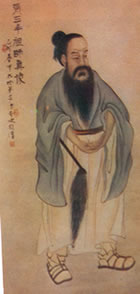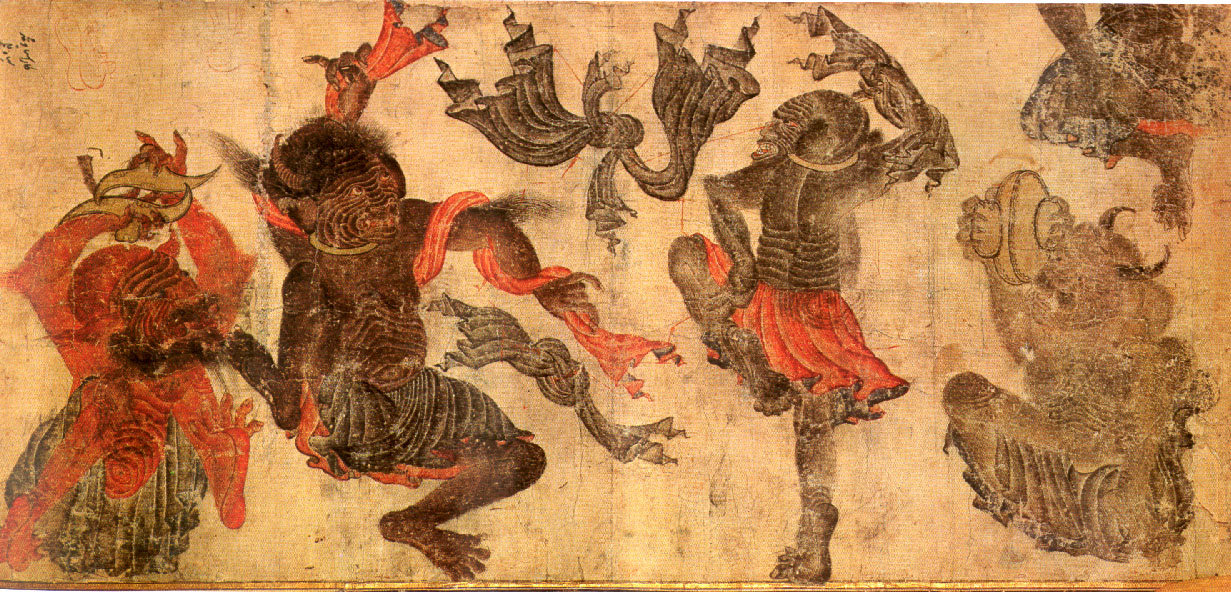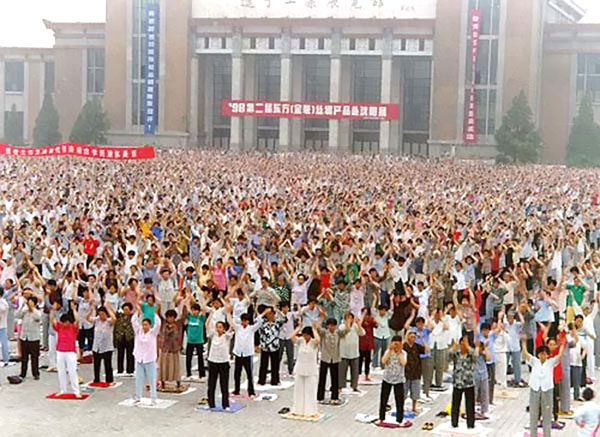I apologize for not writing more lately, I've been swamped with work, but I also promise that the next few weeks of blogging will be above average.
(This is special because, as my regular readers already know, my secret to good blogging is that I make a point of shooting for just below average.)I have a few more things to say about
Qigong Fever: Body, Science, and Utopia in China
, which is now at the top of my list of
recommend books about qigong. ( The two others on the list are
Breathing Spaces
, and
The Transmission of Chinese Medicine
.)
The issues raised in this book have plagued me, and most serious martial artists, since the mid 1990's when the first refugee/exiles from Qigong Fever started pouring into San Francisco and other cities all over the world. At one point local Baji master Adam Hsu got so fed up with all the wacko questions he was fielding he simply declared, "Qi doesn't exist!"
The other day I was at a college faculty meeting sitting next to Professor Yu, a TCM Dermatology teacher I hold in high regard. I showed her my copy of Qigong Fever. Just how relevant this book is, was made immediately apparent by the first thing out of Professor Yu's mouth. "My father invented qigong."
"Oh," I said," Perhaps he is mentioned in this book." As it turns out he is not mentioned in the book. Her father was You Pengxi, a xingyi teacher and early student of
Wang Xiangzhai, the founder of the Yiquan system of internal martial arts. She explained that qigong came from xingyi.
As usually happens when I hear claims about qigong, I found myself trying to find what truth could possibly be behind the claim with out launching into my own agenda. After all, the book is quite clear about the process in which Communist party functionaries chose the term Qigong from a list of terms intended to frame body, breath and mind techniques under a single therapeutic category while intentionally discarding the martial, religious, and conduct transforming aspects of traditional categories.
But of course I do have my own agenda, I grew up practicing gongfu and studied under Bing Gong who was a top student of Kuo Lien-ying who also studied with Wang Xiangzhai. We did standing meditation, and various routines we called warm-ups. No one ever used the word qigong even thought that is what everybody calls it now.
Knowing that of course there could be a hidden history I don't know, I begin with an inclination to agree with Professor Yu. 90% of what I see called qigong is fallout from gongfu schools-- stuff that was taught or invented on a need-to-know basis for students that needed remedial exercises or were developing some unique quality of gongfu.
Unfortunately the profound idea that
all traditional Chinese activities have a Dao--
an efficient way of working or moving that conserves qi-- is not mentioned in the book, nor was it mentioned by Professor Yu.

Professor Yu's father, You Pengxi, was invited, and the CCP gave him permission, to come to Stanford University in 1980 to demonstrate his extraordinary qigong skills. He promptly defected. He had been a wealthy and successful Western trained dermatologist before the revolution (1949). He defected from Communist China the first chance he got. I do not know the details in his case, but it would not have been unusual for a well trained doctor to be publicly tortured and shamed during the Cultural Revolution (1967-1977). As far as I can tell, nobody taught anybody anything during the Cultural Revolution. Because of his association with Wang Xiangzhai (who died in 1963), he may have attracted students shortly after it became possible to teach again, but he can't have been teaching qigong for much more that a year before he defected in 1980. So in that sense he may have indeed been the first qigong master "off the hump." Professor Yu however claimed that he developed and named qigong around 1949.
During the first 15 years of the revolution (the 50's) there was some gongfu training going on, but between fear, repression and
a general lack of food, I have trouble imagining that much quality teaching was taking place. During this period fighting skills were officially scrapped away and discarded while the term gongfu (meritorious skill) was essentially replaced with the word wushu (martial art). I suspect that most of You Pengxi's teaching and martial fame was from before the Communist Revolution. To be fair, their were some gongfu classes happening in the dark, before dawn and after dusk. In my imagination,
admittedly shaped by George Xu, I see these as serious fighting classes where people came home bleeding more days than not.
During the 1950's qigong as a public activity existed only in the Traditional Chinese Medical Hospitals. It was a cheap and patriotic form of therapy. Before the revolution the Communists, like their Republican and Nationalist rivals, were pro-Western science and anti-traditional (superstitious) healing of all kinds.
After the revolution, the combination of anti-Western hysteria, incompetent use of limited funds, and the obvious efficacy and availability of some traditional healing practices, led the CCP to embrace Traditional Chinese Medicine. Qigong was practiced in a very limited way during the 1950's, mainly within the hospital setting.
Professor Yu talked about her childhood memories of Wang Xiangzhai, and her father's closeness to him. She said her father gave Wang Xiangzhai a check book and told him to buy anything he wanted. Also that her father did not charge for lessons and only taught people with virtuous natures. She described her father and her mother's (Yu Ouming) ability to blast multiple attackers to the ground without actually touching them.
They were using qi alone!Magical and extraordinary powers have been around for centuries, but totalitarian Communism didn't leave any space for performance art. The book
Qigong Fever
explains how with the first crack of freedom in the 80's the CCP gave authority to individuals only to the extent that everything they did was in the name of Science and Chinese cultural superiority. All knowledge still belonged to the state, but performers and charismatic could claim that practicing qigong in a scientific way would give you extraordinary powers---
like seeing with your ears, reading peoples minds, or guiding missiles with your qi! A complex network developed consisting of Party officials, charismatic teachers, and researchers who were into qigong. The fact that they managed to make it illegal to criticize or be publicly skeptical of qigong, extraordinary powers, or pseudo-science, helped ignite and sustain the explosion of qigong into everyday life.
When I got home I searched for Professor Yu's father in a PFD collection of essays about Wang Xiangzhai that I downloaded from somewhere in the Internet wilderness. He is credited with being the source of all Yiquan lineages which practice
empty force (gongjin), the ability to throw someone with out touching them.
If such extraordinary powers are possible
(and I'm forbidden by precept from actually commenting on their veracity), I've always thought they would still waste an enormous amount of qi, and thus be in total contradiction with the whole point of daoist inspired practices; namely,
to conserve jing and qi! Not to mention the temptation anyone with actual blood flowing in their veins would have to tip their opponent's hand during a poker game or to cop the occasional feel from across the room. (Yes, I know, I would never be allowed to learn such practices because I'm clearly a man of dark virtues.)
My point here is simple. If anyone
from the people at New Tang Dynasty TV (Falungong) to your friendly neighborhood qi jock wishes to have the right to be taken seriously by me on the subject of qigong--
then they must read Qigong Fever
!

 Last month I was at a family gathering and there was a five month old girl who was crying. Her aunt, who has several wild children of her own, tried rocking her and then bouncing her, but the baby was still crying. Then with a big grin she announced, "We are going to have to try Monkey Swings." I can now verify from my observations that monkey swings are an effective crying control mechanism.
Last month I was at a family gathering and there was a five month old girl who was crying. Her aunt, who has several wild children of her own, tried rocking her and then bouncing her, but the baby was still crying. Then with a big grin she announced, "We are going to have to try Monkey Swings." I can now verify from my observations that monkey swings are an effective crying control mechanism.
 As you are imaging this, you might think that the baby's head would flop backwards like that of the child on the swing above. But it didn't. The baby's head stayed right in line with its torso. This was a five month old I was watching, a younger baby probably would have had a floppy head. An older child would certainly be able to do this, but in most cases it would be obvious that they were using voluntary neck muscles.
As you are imaging this, you might think that the baby's head would flop backwards like that of the child on the swing above. But it didn't. The baby's head stayed right in line with its torso. This was a five month old I was watching, a younger baby probably would have had a floppy head. An older child would certainly be able to do this, but in most cases it would be obvious that they were using voluntary neck muscles.

 I was excited to see
I was excited to see  Douglas Wile's article is called
Douglas Wile's article is called  Them's figtin' words. Bumper stickers have all but disappeared from San Francisco (which I attribute to uniformity of thought); however, I spotted one today. It read, "Lighten Up!"
Them's figtin' words. Bumper stickers have all but disappeared from San Francisco (which I attribute to uniformity of thought); however, I spotted one today. It read, "Lighten Up!" I'm old enough, and was born in the right place, to remember the real New Age. The basis of the New Age movement was the hippy idea that we could change the metaphors we live by. If we changed the games children played from competitive ones to cooperative ones, and we change the stories--the mythologies-- our society perpetuates, we could bring about a new way of being, a New Age. Frankly, it was a fun time to be a kid, even if putting my Cheerios underneath a pyramid didn't really change the taste and even the most cooperative game can be made competitive if there are enough eight-year-old-boy hormones to go around.
I'm old enough, and was born in the right place, to remember the real New Age. The basis of the New Age movement was the hippy idea that we could change the metaphors we live by. If we changed the games children played from competitive ones to cooperative ones, and we change the stories--the mythologies-- our society perpetuates, we could bring about a new way of being, a New Age. Frankly, it was a fun time to be a kid, even if putting my Cheerios underneath a pyramid didn't really change the taste and even the most cooperative game can be made competitive if there are enough eight-year-old-boy hormones to go around. That experience was still not enough to stop me from cringing at the New Age bravado apparent in these
That experience was still not enough to stop me from cringing at the New Age bravado apparent in these  hours start to fall. It was a really finicky process. If he didn't add enough gas, the temperature would keep climbing, and if he added too much if would fall too fast. Both scenarios would ruin the glaze. To make it work he had to watch and continually adjust the process for many hours. And it's not like he could just look at a thermostat, the critical issue was how hot the clay was. When the temperature was rising he could look at clay cones which are pre-formulated to melt at specific temperatures, but that didn't work when the temperature was falling or stalling.
hours start to fall. It was a really finicky process. If he didn't add enough gas, the temperature would keep climbing, and if he added too much if would fall too fast. Both scenarios would ruin the glaze. To make it work he had to watch and continually adjust the process for many hours. And it's not like he could just look at a thermostat, the critical issue was how hot the clay was. When the temperature was rising he could look at clay cones which are pre-formulated to melt at specific temperatures, but that didn't work when the temperature was falling or stalling.




